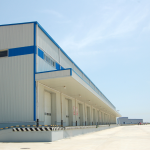New Jersey Future Blog
Next Steps for Warehouse Planning – and Regional Planning More Broadly
September 21st, 2022 by Tim Evans
 The State Planning Commission has adopted new warehouse siting guidance. The next step should be to translate the principles articulated in the guidance into a map indicating the best places for future warehouse growth to take place.
The State Planning Commission has adopted new warehouse siting guidance. The next step should be to translate the principles articulated in the guidance into a map indicating the best places for future warehouse growth to take place.- In preparing the map, the Office of Planning Advocacy should coordinate with the New Jersey Department of Transportation, which is preparing a Freight Plan that will address freight as it moves over the transportation network.
- State efforts to address warehouse growth are serving to highlight the importance of statewide planning—and the long-dormant State Development and Redevelopment Plan—in channeling future growth in a way that makes efficient use of infrastructure and resources while also preserving the state’s quality of life.
The State Planning Commission at its Sept. 7 meeting officially adopted the Warehouse Siting Guidance drafted by the Office of Planning Advocacy (OPA) earlier this summer, intended for use by municipalities in deciding how best to plan for warehouse developments. With the rapid growth of the goods-movement industry in New Jersey in recent years, more municipalities will need help sorting through the issues involved, which the officially adopted Warehouse Siting Guidance is intended to provide.
While the guidance document offers much-needed assistance to local officials who are struggling to anticipate the likely effects of warehouse development, none of its recommendations are mandatory—New Jersey remains a “home rule” state where local governments have authority over land-use decisions. For municipalities that may be interested in operationalizing some of the concepts laid out in the guidance, OPA staff are working on a model ordinance and will be seeking feedback on it in the coming months.
Goods movement is a key pillar of New Jersey’s economy. The wholesale trade (NAICS code 42) and transportation and warehousing (NAICS codes 48 and 49) sectors of the economy account for one out of every eight jobs in the state, the highest percentage among the 50 states. By addressing the land-use needs and impacts of a major statewide industry, the warehouse guidance document serves to bring back into the spotlight the importance of regional planning and OPA’s role in promulgating the New Jersey State Development and Redevelopment Plan (“State Plan”), the policies of which are referenced throughout the warehouse guidance.
A logical next step for OPA would be to translate their guidance into a map indicating the locations of potential development and redevelopment sites that best meet the warehouse-siting criteria articulated in the guidance, similar to how the State Plan map illustrates the principles that animate the Plan playing out on the ground. OPA should coordinate with the New Jersey Department of Transportation (NJDOT), which is currently working on an update of its Statewide Freight Plan (the most recent edition of which dates to 2017), to identify sites that are optimally situated near the regional transportation network and best able to accommodate the truck traffic that large warehouse buildings attract. If the Freight Plan is concerned with moving freight from one place to another, while a state warehouse plan would be focused on the spaces occupied by freight while it is standing still, each process should be able to inform, and be informed by, the other. Sites that appear well-suited to warehouse development from a transportation standpoint could then be compared to map layers illustrating other relevant constraints, like the locations of prime farmland or of lower-income communities already suffering from poor air quality.
A statewide warehouse map and its accompanying analysis could serve as a stand-alone product or could be incorporated into a broader (and overdue) revision of the whole State Plan, which has not been updated since 2001. The point of the State Plan has always been to anticipate future growth and determine how and where to accommodate it in a way that makes the most efficient use of state resources while also preserving the state’s quality of life. These are the questions that shippers and industrial real estate developers are presently confronting with respect to warehouses, but the questions are not unique to the goods-movement industry.
Much has changed about New Jersey’s development landscape in the last 20 years. Targeted growth areas, transportation corridors, land preservation priorities, and redevelopment opportunities all need to be updated to reflect current conditions. Future growth strategies also need to reflect threats from climate change, which Superstorm Sandy, Hurricane Ida, and other major weather events have brought to the fore in the two decades since the State Plan was last updated. If state agencies are to target infrastructure investments and development incentives—whether for warehouses, residential growth, or any other type of development—to places where they best advance the state’s vision of its own future, a new edition of the State Plan would give them an up-to-date baseline from which to work. For these reasons, and more, New Jersey Future supports a robust and inclusive update of the outdated State Plan.
Related Posts
Tags: Development, freight, guidance, infrastructure, municipalities, planning, Redevelopment, state plan, Transportation, warehouse, warehouse development
















